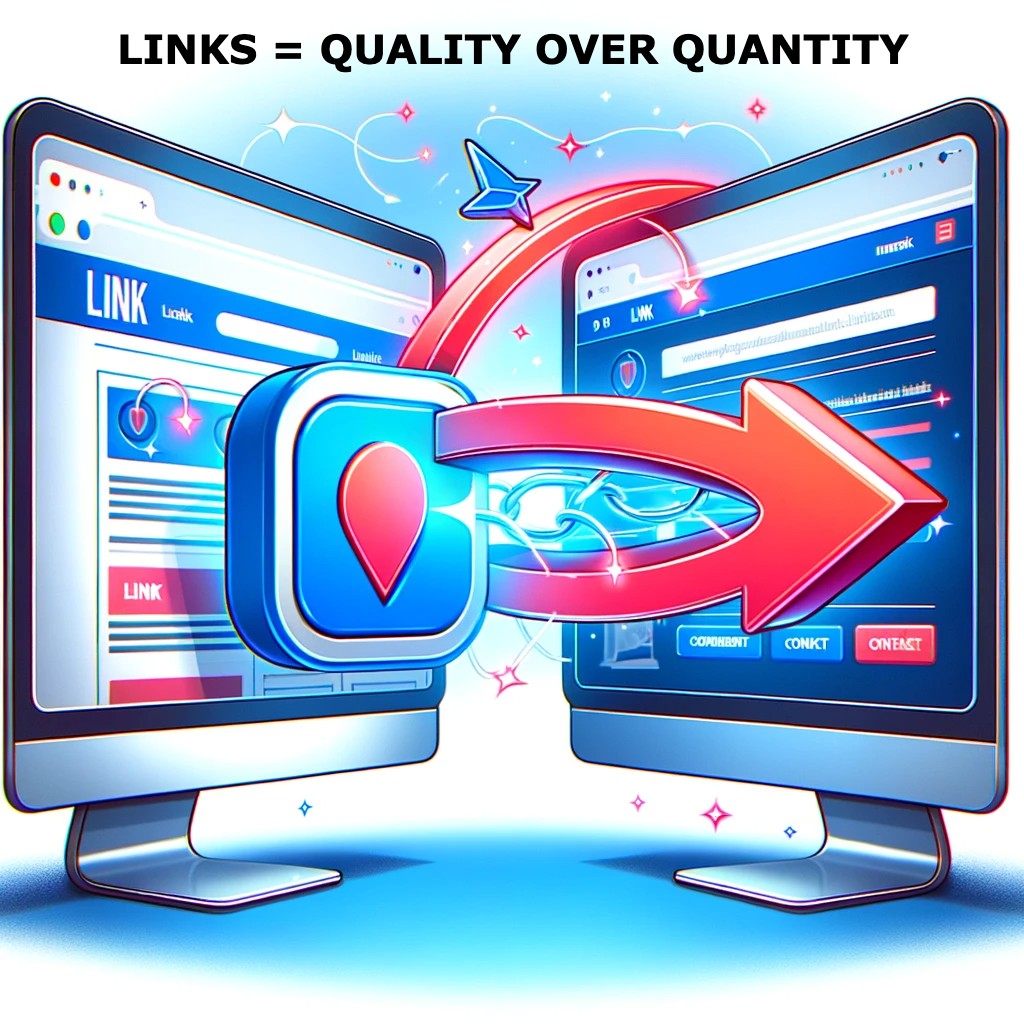In the world of Search Engine Optimization (SEO), backlinks are like the currency of the internet. They signal to search engines that other websites consider your content valuable enough to link to. However, not all backlinks are created equal. As you embark on your SEO journey, understanding the difference between backlink quality and quantity can significantly impact your website’s search engine rankings. This guide will help you navigate this crucial aspect of SEO.
What Are Backlinks?
Backlinks, also known as “inbound links” or “external links,” are links from other websites that point to your site. In the eyes of search engines like Google, each backlink acts as a vote of confidence in your content. The more votes you have, the more authoritative your site appears. However, the influence of these votes depends heavily on the quality of the links.
The Shift from Quantity to Quality
In the early days of SEO, the quantity of backlinks was a dominant factor. Websites that managed to accumulate a large number of backlinks could easily climb the search engine results pages (SERPs). However, this led to manipulative practices such as link farms and paid link schemes, prompting search engines to evolve their algorithms to focus more on the quality of backlinks rather than sheer numbers.
Defining High-Quality Backlinks
A high-quality backlink has several key characteristics that set it apart from lower-quality links:
- Relevance: The linking site’s content should be relevant to your own. A link from a related domain is far more powerful than a link from an unrelated site.
- Authority: Links from well-established, trusted websites carry more weight. A backlink from a site like an educational institution (.edu) or a government entity (.gov) is particularly valuable.
- Traffic: Backlinks from high-traffic websites can bring direct clicks and improve visibility.
- Anchor Text: The clickable text in a hyperlink (anchor text) should be relevant to your page’s content. Optimal use of anchor text can enhance a backlink’s effectiveness.
The Impact of High-Quality Backlinks
High-quality backlinks can significantly enhance your SEO in several ways:
- Improving Ranking: Quality backlinks signal to search engines that your site is a credible source of information, thus improving your rankings in search results.
- Boosting Page Authority: Each quality backlink boosts the authority of your web pages, allowing them to rank higher.
- Driving Traffic: Backlinks from high-traffic sites can lead to increased direct traffic to your site.
- Long-Term Benefits: Unlike low-quality links, which may get devalued by search engine updates, high-quality backlinks provide enduring benefits.
How to Acquire Quality Backlinks
Acquiring high-quality backlinks is not straightforward and involves a strategic approach:
- Content Creation: Create high-quality, informative, and engaging content that naturally attracts backlinks.
- Guest Blogging: Write articles for reputable sites in your industry to receive backlinks through your author bio or content.
- Broken Link Building: Identify broken links on other sites and suggest your relevant content as a replacement.
- Influencer Outreach: Connect with influencers in your field to share your content with their audience.
- Participating in Industry Forums and Discussions: Engage in communities where you can share knowledge and include backlinks organically.
Tools to Monitor Backlink Quality
To manage your backlinks effectively, consider using SEO tools such as:
- Ahrefs: Offers comprehensive tools for backlink analysis.
- SEMrush: Provides detailed backlink audits and analytics.
- Moz Pro: Known for its domain authority metric, which helps assess the quality of potential backlinks.
Focusing on the quality of backlinks rather than quantity is crucial for effective SEO. High-quality backlinks enhance your site’s authority, improve rankings, and drive organic traffic, contributing to long-term SEO success. As you develop your backlink strategy, aim for links that meet the high-quality criteria discussed, and use the right tools to monitor and analyze your backlinks. Remember, in the realm of SEO, a few high-quality backlinks can be more impactful than hundreds of low-quality links.
By taking the time to build your backlinks intelligently, you’re not just improving your SEO; you’re setting a foundation for sustained online success.

Strategic Approaches to Avoid Common Backlink Pitfalls
In the pursuit of high-quality backlinks, it’s crucial to recognize and steer clear of common pitfalls that could potentially harm your SEO efforts. Here’s how to navigate some of these challenges:
1. Avoiding Low-Quality Links
Low-quality links come from spammy, irrelevant, or low-authority websites. These can negatively impact your SEO. It’s important to conduct regular backlink audits to identify and disavow these harmful links.
2. Escaping the Private Blog Networks (PBN) Trap
Private Blog Networks (PBNs) are groups of websites created solely for linking purposes. Initially, PBNs were a shortcut to high rankings, but today, they are heavily penalized by search engines. Avoid using such schemes to ensure your SEO stays penalty-free.
3. Diversifying Your Link Profile
Relying on a single source or type of backlink can make your SEO strategy vulnerable to changes in search engine algorithms. Diversify your backlink profile by acquiring links from different types of websites, across various industries, and using varied anchor texts.
4. Focusing on Link Earning Instead of Link Building
Transition your strategy from actively building links to earning them through high-quality content and genuine relationships in your industry. This approach not only yields better SEO results but also creates more sustainable and ethical link growth.
Examples of Effective Backlink Strategies
To give you a clearer idea of how to implement these strategies, here are a few examples of effective backlink acquisition:
a. Content-Driven Link Acquisition
- Infographics: Create visually appealing infographics that provide valuable information. Well-designed infographics are likely to be shared and linked back by various websites.
- Data-Driven Content: Publish original research, surveys, or studies. This type of content is highly linkable and can establish your site as a thought leader in your niche.
b. Relationship-Based Link Building
- Collaborations and Partnerships: Collaborate with other businesses or influencers to create content that includes mutual backlinks.
- Community Participation: Engage in community discussions in your field, contribute to forums, and participate in webinars where you can share your insights and your site’s link.
c. Authority Building
- Guest Posts on Reputable Sites: Write high-quality guest posts for well-established sites in your industry. These should provide value to the reader and naturally include a backlink to your site.
- Interviews and Expert Panels: Participate in interviews or discussions as an expert in your field. These platforms often provide opportunities to gain authoritative backlinks.
Monitoring and Measuring Backlink Effectiveness
After implementing your backlink strategy, it’s essential to monitor and measure the effectiveness of your links. Tools like Google Analytics and SEO platforms like Ahrefs or SEMrush can help you track:
- Referral Traffic: The amount of traffic each backlink drives to your site.
- Link Value: Assessing which backlinks bring the most value in terms of authority and traffic.
- Ranking Improvements: Observing how specific backlinks impact your overall search engine rankings.
Conclusion
The journey towards mastering backlink quality over quantity involves a strategic approach centered around creating valuable content, engaging genuinely with your industry, and continually monitoring your progress. By focusing on building high-quality backlinks, you ensure the longevity and effectiveness of your SEO efforts, leading to better rankings, more organic traffic, and ultimately, higher credibility and trust from your audience.
Through consistent effort and adherence to best practices, you can build a backlink profile that not only boosts your SEO but also supports the growth and success of your online presence.
References:
- Ahrefs
- SEMrush
- Moz Pro
- Google Analytics



